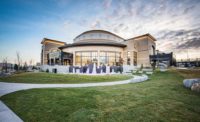High-tech theater is coming to the Salt Lake City suburbs as a new family-centered venue nears completion. The $80-million Hale Centre Theatre (HCT), part of the growing Cairns master-planned development in Sandy, Utah, will make extensive use of technology and custom-engineered staging from a world-class designer.
For nearly 32 years, the nonprofit theater company has performed popular plays and musicals targeted at families. The need to keep ticket prices affordable and offer more high-quality performances drove the decision to build a new theater, says Mark Dietlein, HCT president and CEO.
“About seven years ago, our board started to look at our long-term future,” Dietlein says. “The analysis showed that our ticket prices would have to go up substantially as time went on [if seating capacity wasn’t increased].”
Dietlein says a major expansion of the HCT’s current facility was deemed unfeasible for a number of reasons, and the group began looking for a new location. Sandy, about 20 miles south of Salt Lake City, is building a mixed-use development known as the Cairns on 1,100 acres of vacant land east of Interstate 15 and adjacent to the city hall complex.
Sandy Mayor Tom Dolan says city leaders liked the idea of having a modern theater in their community. “The Hale has been successful for so many years; it is good family entertainment and many people in Sandy are season ticket holders. It just fit well in our long-term plans to be a great suburban community.”
Sandy City agreed to bond for $42.7 million to bring the 105,855-sq-ft theater to the Cairns. Dietlein said HCT will repay the bond over time and eventually own the building, an option the company did not have in its previous location.
Taking Center Stage
From its beginnings HCT has performed theater-in-the-round. Dietlein says a commitment to those performances drove the design of the new venue. “Surveys of our patrons found they wanted us to keep that immersive theater experience. They also wanted to be able to attend shows more,” he says. “The stage is the heart of the theater, and everything else is ancillary. We started with the stage and designed out from there.”
The new venue will have two stages. In addition to the theater-in-the-round configuration, with seating for 900, it will include a smaller “jewel-box” theater with a proscenium-thrust stage and seating for 461 people. The addition of the second theater will allow the group to perform more plays.
Architect Lyle Beecher of Holladay, Utah-based Beecher Walker Architects says the form of the building, starting with the round stage, integrated well into the site, which is located along a curved frontage road.
“When we settled on this site, I was very excited,” Beecher says. “Not only because we have great access off I-15, but on the other side of the site we have this meandering, curved road that catered very well to the curves of the building.”
New Depths for New Heights
With the articulated, slightly oval-shaped stage, sets can be changed by lowering the stage out of sight rather than having to place the sets in from above using a traditional theater fly-loft. Creating the below-stage space required digging a pit 50 ft wide and 70 ft below grade. It also created the first challenge for Sandy-based Layton Construction, which won the construction manager/general contractor contract for the project.
“We hit groundwater about 6 ft underground,” says Layton project manager Jared Adamson. Crews installed dewatering wells and pumped out about 200 gallons a minute for the first several months. Adamson says that’s now down to about 60 gpm, but the building will have a permanent dewatering system.
To create the sub-pit, Adamson says crews drove 40 sheet piles and placed concrete, which was then waterproofed. Beecher notes there are also piles under the pit to help hold it in place.
“The soil does not hold compressive strength,” Adamson says. “We had to put piles down past a layer of sand to get to bedrock. We have to have piles holding the building up and piles to hold it in place.” The cast-in-place building sits on a total of 225 piles, some at depths of more than 70 ft.
“The concrete serves two purposes for us,” says Adamson. “It is great for sound insulation. We are close to the freeway, which is good for access, but you have the noise. We also needed concrete for seismic issues.”
The walls went up using gang forms and scaffolding in a series of 16-ft lifts, Adamson says. “We had an engineer show us a bracing system. We would go up about 45 ft and then we’d have to do bracing and tying into adjoining walls,” he says. “With a traditional wall, you are sitting on a footing, but here we are on a 3-ft by 3-ft pile cap so we had to brace the walls or it would break off at that pile cap.”
The thickest wall in the structure is the 18-in. barrier between the two theaters. An EMF-blocking wire mesh was imbedded in the wall to prevent signals from the wireless stage microphones crossing over from one performance space to the other.
The fly-loft rises 100 ft above grade and is centered over the building to serve both performance spaces. Suspended in the fly-loft is part of the stage production mechanics custom-designed for the Hale by TAIT Towers, an international live event and entertainment technology company known for designing stages for world tours and theaters.
The HCT fly-loft system includes two gantry-crane trolleys that can traverse the stage, rotate and raise and lower set pieces and people at up to 6 ft per second using multiple hoists. It has a total lifting capacity of 6,000 lb. Spanning 150 ft across the top of the fly-loft are six 80,000-lb girders that were transported in four sections and welded on site.
Below the fly-loft is the multi-sectioned, articulated stage of the main theater. The slightly oblong stage has 47 moving parts powered by 130 motors that can lift and turn various segments. It is flanked by four passageways that also include lift sections. The lifts can raise and lower loads at up to 1 ft per second. When the stage is lowered, the pit can be covered by two slip-stages that glide in from opposite sides at up to 4 ft per second.
Other technology includes a theater-wide audio induction loop system that transmits signals from stage microphones directly into the hearing aids of patrons. A plenum floor in the theaters delivers heated air at numerous outlets near the seats using a high-capacity and low-velocity mechanical system.
Beecher says for all the technology built into the new theater, the team also tried to include enough flexibility in the design so that future technologies can be easily integrated into the venue.
The theater will open in two phases, with performances for the jewel-box theater scheduled for Sept. 1 and those for the main theater-in-the-round set for November.







